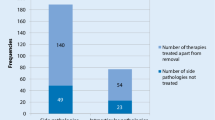Abstract
Objective
To provide new epidemiological data regarding the prevalence, distribution and macroscopic features of shoulder rotator cuff calcific tendinopathy (calcific tendinopathy), and to identify the characteristics of calcific deposits associated with shoulder pain.
Materials and methods
Three hundred and two female volunteers (604 shoulders) who had been referred to a gynaecological clinic participated in the study. The subjects underwent a high-resolution ultrasonography of both shoulders, and those with a diagnosis of calcific tendinopathy compiled a standardized questionnaire relating to shoulder symptoms. We determined the prevalence of symptomatic and asymptomatic rotator cuff calcific tendinopathy, and compared differences in distribution and macroscopic features of the symptomatic and asymptomatic calcifications.
Results
The prevalence of calcific tendinopathy was 17.8 % (103 shoulders). Ninety-five shoulders (15.7 %) were symptomatic; of these, calcific tendinopathy was found in 34 shoulders (33 %) on imaging. Of the 509 asymptomatic (84.3 %) shoulders, calcific tendinopathy was observed in 69 cases (67 %). Among tendons, supraspinatus (53.4 %) and infraspinatus (54.6 %) were the most frequently involved. The majority of calcific deposits were of maximum diameter between 2 and 5 mm (77.9 %), and were linear in form (69.9 %). The involvement of multiple tendons and a location in the supraspinatus tendon were found to be significantly correlated with pain (p = 0.023, p = 0.043 respectively), as were age (p = 0.041) and an excessive body mass index (p = 0.024).
Conclusion
In this sample from the general population of working age females, both intrinsic factors (location in supraspinatus, multiple tendon involvement) and extrinsic variables (age, abnormally high BMI) were correlated with pain in calcific tendinopathy. Level of evidence: Level III, cross-sectional study, prevalence study.



Similar content being viewed by others
References
Bosworth BM. Calcium deposits in the shoulder and subacromial bursitis: a survey of 12,122 cases. J Am Med Assoc. 1941;116:2477–82.
Farin PU, Jaroma H. Sonographic findings of rotator cuff calcifications. J Ultrasound Med. 1995;14:7–14.
Clavert P, Sirveaux F. Société française d’arthroscopie: Les tendinopathies calcifiantes de l’épaule [Shoulder calcifying tendinitis]. Rev Chir Orthop Reparatrice Appar Mot. 2008;94(8):S336–55.
Mavrikakis ME, Drimis S, Kontoyannis DA, Rasidakis A, Moulopoulou ES, Kontoyannis S. Calcific shoulder periarthritis (tendinitis) in adult onset diabetes mellitus: a controlled study. Ann Rheum Dis. 1989;48:211–4.
McKendry RJ, Uhthoff HK, Sarkar K, Hyslop PS. Calcifying tendinitis of the shoulder: prognostic value of clinical, histologic, and radiologic features in 57 surgically treated cases. J Rheumatol. 1982;9(1):75–80.
Uhthoff HK, Loehr JW. Calcific tendinopathy of the rotator cuff: pathogenesis, diagnosis, and management. J Am Acad Orthop Surg. 1997;5:183–91.
De Palma AF, Kruper JS. Long-term study of shoulder joints afflicted with and treated for calcific tendinitis. Clin Orthop. 1961;20:61–72.
Le Goff B, Berthelot JM, Guillot P, Glémarec J, Maugars Y. Assessment of calcific tendonitis of rotator cuff by ultrasonography: comparison between symptomatic and asymptomatic shoulders. Joint Bone Spine. 2010;77(3):258–63.
Ogon P, Suedkamp NP, Jaeger M, Izadpanah K, Koestler W, Maier D. Prognostic factors in nonoperative therapy for chronic symptomatic calcific tendinitis of the shoulder. Arthritis Rheum. 2009;60(10):2978–84.
Chiou HJ, Chou YH, Wu JJ, Hsu CC, Huang DY, Chang CY. Evaluation of calcific tendonitis of the rotator cuff: role of color Doppler ultrasonography. J Ultrasound Med. 2002;21(3):289–95.
Papatheodorou A, Ellinas P, Takis F, Tsanis A, Maris I, Batakis N. US of the shoulder: rotator cuff and non-rotator cuff disorders. Radiographics. 2006;26(1), e23.
Teefey SA, Rubin DA, Middleton WD, Hildebolt CF, Leibold RA, Yamaguchi K. Detection and quantification of rotator cuff tears: comparison of ultrasonographic, magnetic resonance imaging, and arthroscopic findings in seventy-one consecutive cases. J Bone Joint Surg Am. 2004;86-A(4):708–16.
Entrekin RR, Porter BA, Sillesen HH, Wong AD, Cooperberg PL, Fix CH. Real-time spatial compound imaging: application to breast, vascular, and musculoskeletal ultrasound. Semin Ultrasound CT MR. 2001;22(1):50–64.
Kuorinka I, Jonsson B, Kilbom A, Vinterberg H, Biering-Sørensen F, Andersson G, et al. Standardized Nordic Questionnaire for the analysis of musculoskeletal symptoms. Appl Ergon. 1987;18:233–7.
Sansone V, Meroni R, Boria P, Pisani S, Maiorano E. Are occupational repetitive movements of the upper arm associated with rotator cuff calcific tendinopathies? Rheumatol Int. 2014. doi:10.1007/s00296-014-3086-z.
Chiou HJ, Chou YH, Wu JJ, Huang TF, Ma HL, Hsu CC, et al. The role of high-resolution ultrasonography in management of calcific tendonitis of the rotator cuff. Ultrasound Med Biol. 2001;27(6):735–43.
Yamamoto A, Takagishi K, Kobayashi T, Shitara H, Osawa T. Factors involved in the presence of symptoms associated with rotator cuff tears: a comparison of asymptomatic and symptomatic rotator cuff tears in the general population. J Shoulder Elb Surg. 2011;20(7):1133–7.
Tashjian RZ. Epidemiology, natural history, and indications for treatment of rotator cuff tears. Clin Sports Med. 2012;31:589–604.
Wendelboe AM, Hegmann KT, Gren LH, Alder SC, White GL, Lyon JL. Associations between body-mass index and surgery for rotator cuff tendinitis. J Bone Joint Surg Am. 2004;86:743–7.
Gumina S, Candela V, Passaretti D, Latino G, Venditto T, Mariani L, et al. The association between body fat and rotator cuff tear: the influence on rotator cuff tear sizes. J Shoulder Elb Surg. 2014;23(11):1669–74.
Frot M, Feine JS, Bushnell MC. Sex differences in pain perception and anxiety: a psychophysical study with topical capsaicin. Pain. 2004;108:230–6.
Acknowledgements
The authors wish to thank Jocelyn McCleery and Giulio Valerio Sansone for their assistance in the preparation of this manuscript.
Conflict of interest
The authors declare that they have no conflict of interest
Author information
Authors and Affiliations
Corresponding author
Rights and permissions
About this article
Cite this article
Sansone, V., Consonni, O., Maiorano, E. et al. Calcific tendinopathy of the rotator cuff: the correlation between pain and imaging features in symptomatic and asymptomatic female shoulders. Skeletal Radiol 45, 49–55 (2016). https://doi.org/10.1007/s00256-015-2240-3
Received:
Revised:
Accepted:
Published:
Issue Date:
DOI: https://doi.org/10.1007/s00256-015-2240-3




